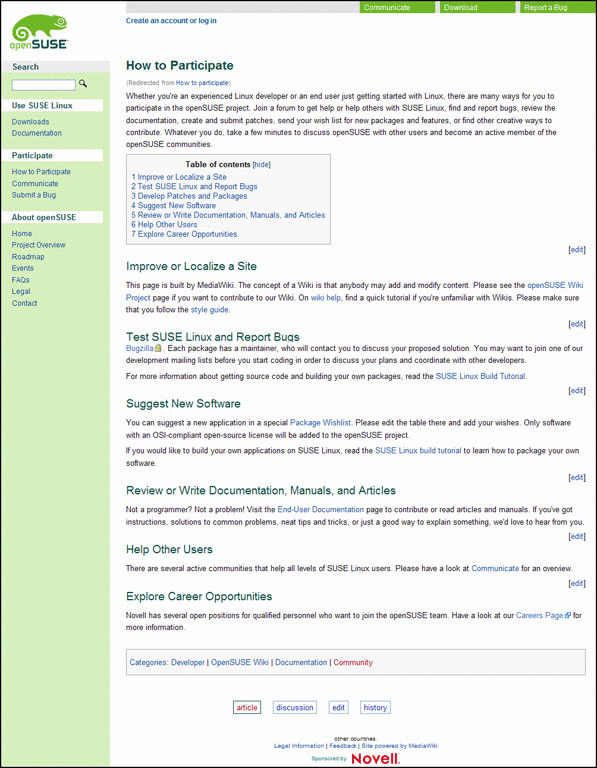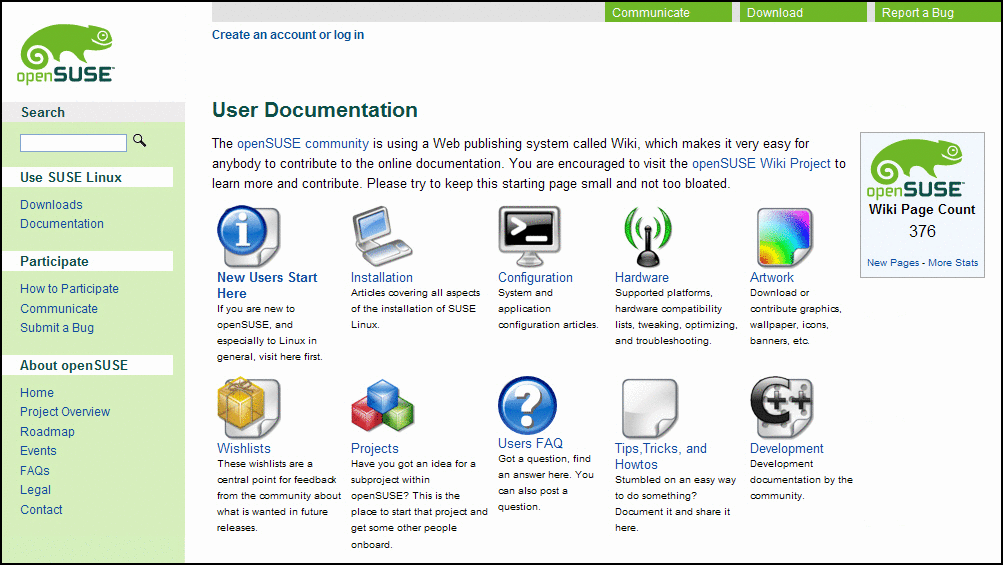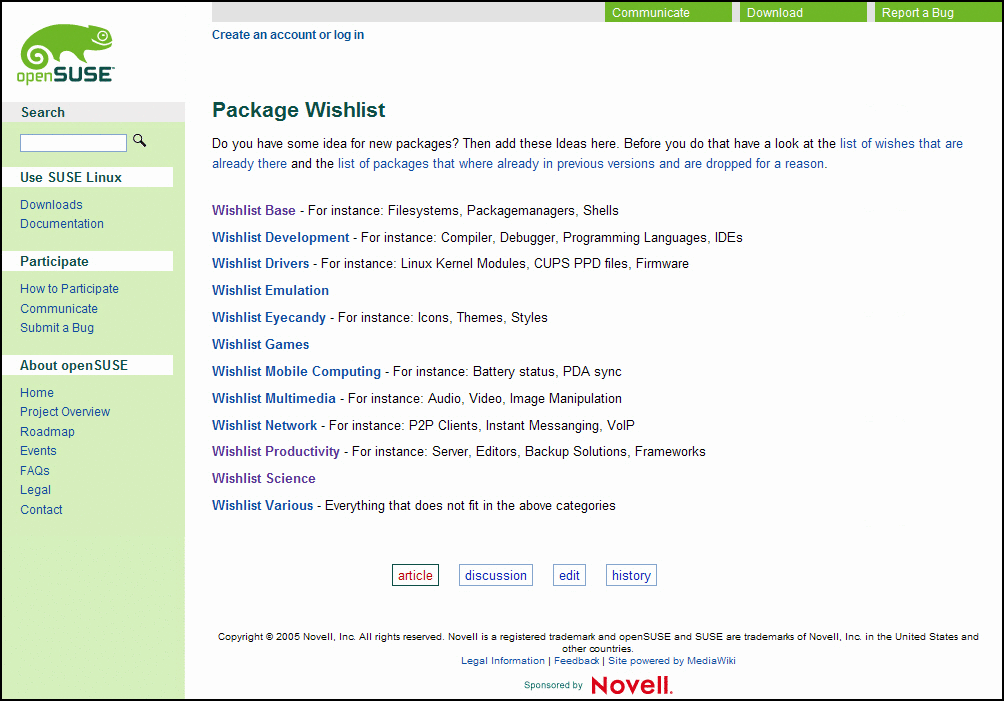Go Ahead. It's Open.
Articles and Tips:
01 Feb 2006
Novell has done it again! It has further enhanced its support for, and commitment to, Linux and the open source movement by sponsoring a new project: openSUSE. The most visible manifestation of this support is the new Web site: openSUSE.org. You'll find a great deal of information related to SUSE and open source on this site. Not only will you find documentation and other links, but this is also where betas and development releases are posted. You can also report bugs through the Bugzilla database, participate as a developer and much more.
The openSUSE project was created to promote the use of Linux everywhere by providing free access to SUSE Linux, the most usable distribution of Linux on the market today. According to Novell, the goals of this project are three-fold:
Make SUSE Linux the easiest Linux distribution for anyone to obtain and the most widely used open source platform.
Provide an environment for open source collaboration that makes SUSE Linux the world's best Linux distribution for new and experienced Linux users.
Dramatically simplify and open the development and packaging process to make SUSE Linux the platform of choice for Linux hackers and application developers.
This isn't just a movement aimed at those who stay up until the wee hours of the morning digesting source code. Everyone in the Linux community, regardless of their prior knowledge, is encouraged to participate in some capacity in the project and there are many ways to do so as outlined. (See Figure 1)
Figure 1: Everyone in the Linux community, regardless of their prior knowledge, is encouraged to participate in some way in the openSUSE project. You can get involved in the Web site, testing or developing the code, documentation and more.

Among them is a great need for those who are simply willing to test SUSE Linux and report problems; the greater the number of testers, the more stable and bug free the final build will be. Help is also needed to improve or localize the site, develop patches and packages, suggest new software to be included with the operating system, write documentation, and help other users.
In an interview with Greg Mancusi-Ungaro, Novell director of marketing for Linux and open source, he said, "We're moving from a closed model where the code was tested in-house, to a completely open and transparent model," that is open to all input. Every voice in the Linux community now has the ability to use the software as it is being developed, help comment on it and refine it through each phase of the process.
On the openSUSE Web site, you can find links to upcoming events, news and project milestones. The events include those for Novell as well as those for Linux in general, as the company continues to move from a proprietary model to more of a portal-based one.
Novell will continue to package and sell SUSE Linux to users who would rather have a physical product in their hands than download from the Web. In addition to the physical box and media, the retail product will differ in that it will have printed copies of the manuals, include support and whatever commercial software is to be included along with the operating system.
That last item is very important, and you should note that when you download the software from the site, you get only the SUSE Linux operating system and not the other commercial software that accompanies the retail version of the product, such as the browser plugins. The components that aren't included are easy to obtain and install, but you'll need to plan your time so you don't start the process right before quitting time on a Friday afternoon.
The main reason for not including the other applications in the download version is because of the licensing agreements with the vendors of those applications; you must usually agree to each of their licenses to legally be in compliance with them.
Register at openSUSE.org if you want to edit the wiki or report bugs in bugzilla. Just give your e-mail address to subscribe to a mailing list. You can access everything else, including code, as an anonymous user.
From the perspective of potential customers, the project is a definite plus for Novell. William Steen, Information Technology Coordinator for Tipton County, Indiana, is in the process of determining whether to stay with the platform currently in place or move to an open source solution and was impressed by what he saw: "I think the openSUSE project illustrates Novell's commitment to the open source movement. They didn't come into the Linux market and start shutting the doors behind them--which they easily could have done given their size," he said. "Instead, they came into the market and offered to make sure the doors stay open for everyone else as well. You have to admire them for that, and it is one of the considerations we are looking at as we evaluate migrating to SUSE Linux." Steen mentioned how some of the county commissioners are afraid of being locked into proprietary solutions and this gives him one more bullet to use when trying to sell the migration to them.
On openSUSE.org, communication of issues related to the project is done through mailing lists, IRC (Internet Relay Chat), and Web forums. Documentation includes the usual FAQs, product highlights and much more. Currently, the SUSE Linux Reference is available online in its entirety as a 786-page PDF. You will be hard pressed to find such a comprehensive, and current manual anywhere else for free.
User documentation on the site (See Figure 2) is divided into several sections:
New Users Start Here is a collection of items most relevant to users who are new to Linux and/or new to SUSE Linux.
Installation contains documents and articles obviously covering the installation of the OS. For the most part, installation is amazingly simple: download the ISO images, burn them onto CD or DVD and start the installation from those. It gets a bit more complicated when you start installing across the network and such, and that is why these installation files are available on the site.
Configuration holds information on tweaking the system as well as applications.
Hardware not only contains lists of the supported platforms and hardware, but also troubleshooting information and notes on finetuning and optimizing specific settings.
Artwork houses the usual collection of wallpaper, icons and miscellaneous graphics.
Wishlists currently has three subsections: Use the Package Wishlist to suggest including a package you think the current build should have (See Figure 3); use the Feature Wishlist to suggest a feature you'd like to have included; and use the OpenSUSE Wishlist for the project itself, Web site or other such item.
User Projects offers the ability to start a subproject and get other people onboard and involved.
Users FAQ not only lets you look for answers to the questions you have, but you can also post new questions that aren't answered in the FAQ.
Tips, Tricks and How-tos lets you search for others' documentation or create your own and post it to be shared with everyone else in the community.
Development currently has items on Qt and how to set up a build server.

Figure 3: The Wishlists section currently has three subsections: Use the Package Wishlist to suggest including a package you think the current build should have; use the Feature Wishlist to suggest a feature you'd like to have included; and use the openSUSE Wishlist for the project itself, Web site or other such item.

Opening the doors to developers creates an enormous opportunity for Novell's Linux to become the dominant Linux distribution throughout the world. Jeff Durham, a consultant for small- to medium- sized businesses in the Midwest United States and a creator of several small applications, couldn't be more pleased with the way Novell is opening its source code to developers: "It has long been the belief that SUSE Linux is the most robust operating system on the market; however, Novell was dragging behind by not offering something similar to Red Hat's Fedora for developers to be able to freely get the code and work with it. With openSUSE now underway, they've not only followed that lead, but also have the opportunity to surpass Red Hat." Durham has already downloaded the latest builds from the site and is working with them. The Project Milestones, posted on the main page, offer dates when subsequent builds will be available and he has circled them on his desk calendar.
Novell's commitment to Linux development does not stop merely at SUSE Linux. Instead, Novell is creating a build service for external developers that is based on the AutoBuild system to help developers create applications that run on multiple architectures. AutoBuild simplifies the development process of writing applications and assures the apps will run--as they should, and be supported--throughout the community. The build service will too.
One process currently underway at the project is the exporting of the SUSE Support Database (known as SDB) to a wiki. By turning it into a wiki, it allows anyone to edit and enhance the entries within the database. Localized wikis will exist to account for language differences; German, French and Spanish are the first three planned, in addition to English.
While the openSUSE project has a lot to offer now, the project is far from finished. Plans call for phase two to be implemented in March or April 2006 and includes a simplified patch-submission process and personalized developer accounts. Phase three is slated to follow in the middle of 2006 and calls for a complete community infrastructure allowing, among other things, packagers to quickly create packages and include them in the latest test versions of the distribution.
As such, the openSUSE project is the door into the Linux world for new users, developers and enthusiasts worldwide. By making it easier for users to access the operating system, it makes it easier for them to adopt it. By opening the code to developers, it simplifies their work and will help make SUSE Linux the most used Linux distribution in the world. Finally, by welcoming enthusiasts, and listening to their concerns and wishes, the operating system benefits with each successive generation of the product.
Finally, in addition to the openSUSE project, Novell and other members of the openSUSE project also support a plethora of other projects currently in the works. These projects range from Beagle; which is a search tool; to Mono; which provides the necessary software to develop and run .NET client and server applications on Linux, Solaris, Mac OS X, Windows and Unix; and everything in between. You can find a current list of supported projects.
More Information
For more information on openSUSE, visit the site at openSUSE.org; not only will you be impressed by the simplicity of it, as compared to many other sites, but you'll also find the answers to most of your questions. I also highly recommend listening to, and viewing, the Webcast between Greg Mancusi-Ungaro and Ted Haeger, Director of User Communities, that was put together for the Novell Users International group. This can be accessed here.
About the Author
Emmett Dulaney is the author of the Novell Certified Linux Professional (CLP) Study Guide (ISBN: 0-672-32719-8) and Novell Linux Desktop 9 Administrator's Handbook (ISBN: 0-672-32790-2) by Novell Press. He holds a number of Linux and other certifications.
* Originally published in Novell Connection Magazine
Disclaimer
The origin of this information may be internal or external to Novell. While Novell makes all reasonable efforts to verify this information, Novell does not make explicit or implied claims to its validity.